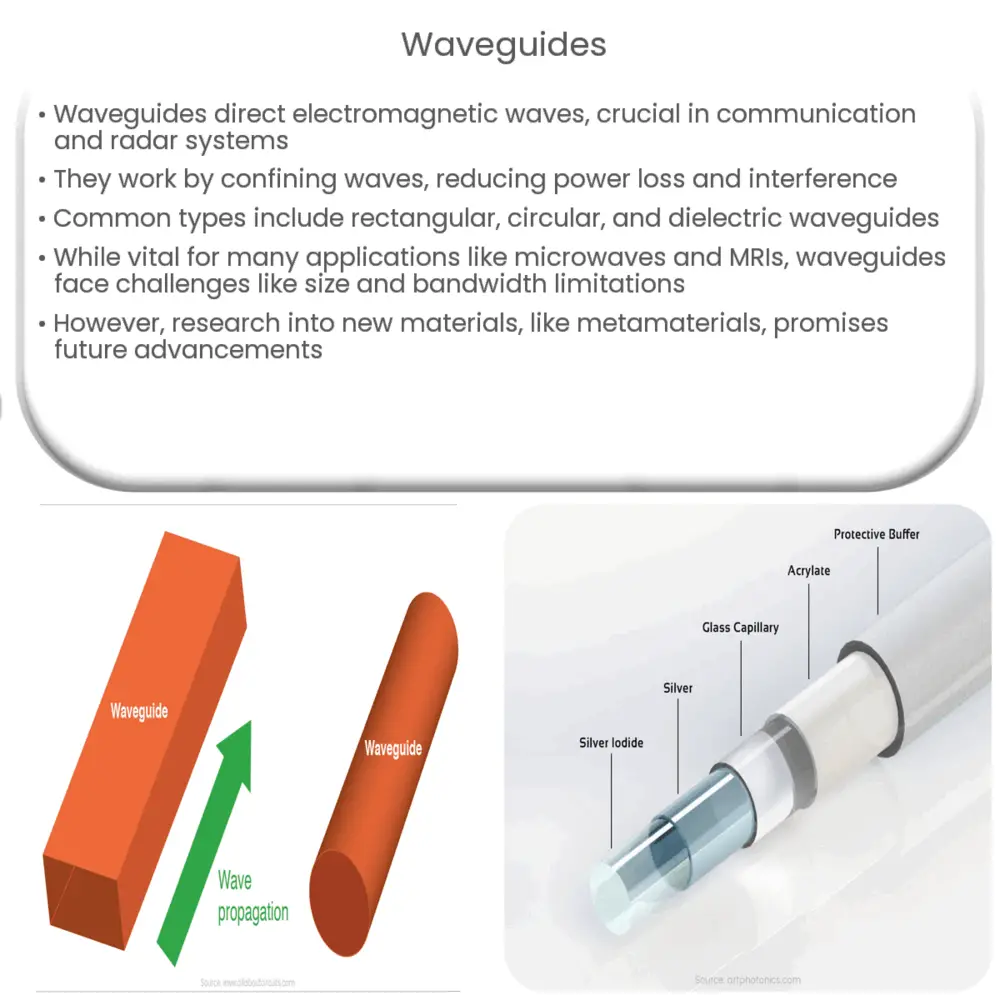Explore the fascinating world of waveguides: their types, modes, applications, challenges, future developments, and crucial role in communication and technology.

Introduction to Waveguides
A waveguide is a physical structure used to direct electromagnetic waves from one place to another. This specialized technology forms the backbone of many communication and radar systems, enabling the transmission and manipulation of signals at microwave frequencies.
The Fundamental Concept
In essence, a waveguide works by confining the electromagnetic waves to one or more paths, dictated by its structure. This enables a significant reduction in power loss and interference, as the waves remain focused, instead of dispersing in all directions as they naturally would.
Types of Waveguides
- Rectangular Waveguides: This is the most common type of waveguide, often used in radar technology. It features a hollow, rectangular tube structure, allowing it to handle a wide range of frequencies.
- Circular Waveguides: As the name suggests, these waveguides have a circular cross-section. They are typically used in systems requiring rotational symmetry, such as circularly polarized antennas.
- Dielectric Waveguides: These waveguides consist of a dielectric material — an insulator that can be polarized by an applied electric field. They are commonly used in integrated optics and optical fibers.
Understanding Wave Modes in Waveguides
Electromagnetic waves traveling through a waveguide can follow different patterns, known as ‘modes’. These modes depend on the physical dimensions and the frequency of the wave. Each mode represents a unique pattern of electric and magnetic field distribution within the waveguide. In a rectangular waveguide, there are two principal modes:
- Transverse Electric (TE): In this mode, the electric field is entirely transverse, i.e., perpendicular to the direction of propagation. There is no electric field component in the direction of propagation.
- Transverse Magnetic (TM): Conversely, in the TM mode, the magnetic field is entirely transverse, and there is no magnetic field component in the direction of propagation.
Importantly, a particular waveguide can support multiple modes, but each mode requires a different minimum cutoff frequency to propagate. Below this frequency, the wave is attenuated and does not pass through the waveguide.
Applications of Waveguides
Waveguides have numerous applications in a broad range of fields. Let’s take a look at some of the most common uses:
- Communications: Waveguides are essential in microwave communication systems, including satellite and radar technologies. They can transfer data over long distances with minimal signal loss.
- Medicine: In medicine, waveguides are used in medical imaging systems, like MRI machines, to transmit radio frequency signals.
- Particle Accelerators: In physics research, waveguides are used to accelerate particles in devices such as linear accelerators and cyclotrons.
- Optical Fiber: The dielectric waveguides, in particular, are used in optical fibers, facilitating high-speed data transmission over long distances.
Challenges and Limitations
While waveguides offer several advantages, they are not without their challenges. First, designing and fabricating waveguides with precision is a complex task, particularly at high frequencies. Additionally, waveguides are usually bulky and not suitable for compact devices. They also have limitations related to bandwidth and power handling, which can impact their efficiency in certain applications.
Future Developments
The rapid development of technology and material science has paved the way for the evolution of waveguides. Researchers are exploring new materials and innovative designs to overcome current limitations. For instance, the advent of metamaterials — artificially structured materials with unique properties — is promising for the development of more efficient waveguides.
Conclusion
Waveguides play a pivotal role in the modern world, from communications to medicine and scientific research. Despite some challenges, their importance is likely to continue growing with the advancement of technology. The ongoing research into new materials and designs is expected to address the existing limitations and open up new possibilities for the use of waveguides. As we continue to depend on the reliable transmission of data and signals, understanding and improving waveguides remain a crucial scientific endeavor.

